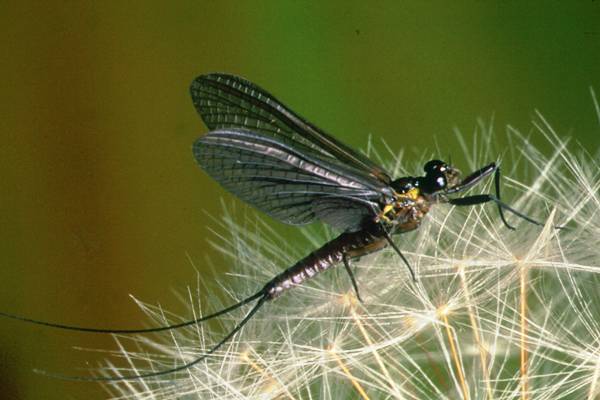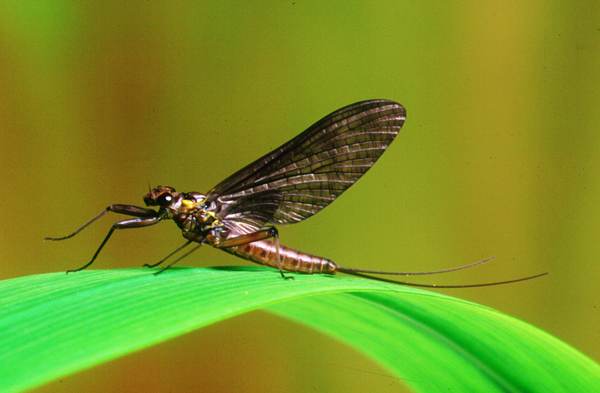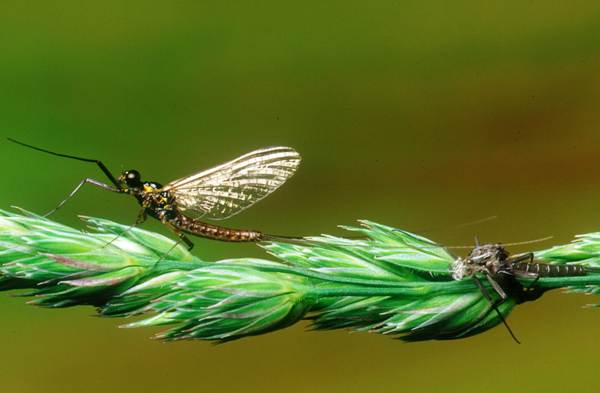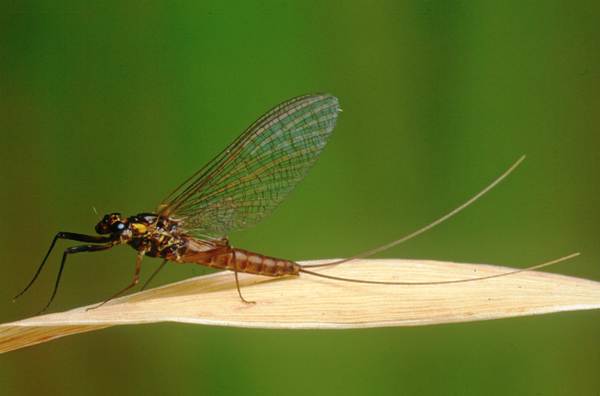Electrogena lateralis - Dusky Yellowstreak
Phylum: Arthropoda - Class: Insecta - Order: Ephemeroptera - Family: Heptagenidae

Dusky Yellowstreak dun (male)
The nymph of the Dusky Yellowstreak (also referred to as the Dark Dun) is a stone clinger and is far more common on spate rivers than on chalk streams; it also occurs on some upland lakes that have shallow stony shores exposed to the wind. This fly is fairly common on the River Teifi in West Wales, our home river, and on many other Welsh spate rivers.

A female dun of the Dusky Yellowstreak
Dun or subimago
The main hatch of Dusky Yellowstreaks usually begins in late afternoon throughout the summer months. Unusually for a mayfly, the nymphs eclode on the riverbed in riffle sections and the duns surface, generally in sparse numbers, and very soon fly off into surrounding vegetation. The female is similar to the male, but with noticeably smaller eyes.

A male spinner of the Dusky Yellowstreak
Flyfishers do not need a close imitation of the Dusky Yellowstreak dun because they emerge in small numbers at a time when very little surface other surface food.

A female spinner of the Dusky Yellowstreak
Spinner or imago
The female spinner of the Dusky Yellowstreak is less dusky than the dun, and its mirror-like shining wings and longer tails distinguish it from the dun. Its wings are transparent, with dark veining.
The males swarm (something of a misnomer, really) in smallish groups and quite often mating occurs well away from the river; so it is the female spinner that can become a trout's dinner. On warm evenings from sunset until dusk the female spinners return to the water to lay their eggs. A sparse fall of spinners can cause a sporadic rise, but a close imitation of the spent spinner is almost certainly not necessary.
The male spinners are similar to the females, but the bodies are rather darker and they have larger eyes. Because they rarely fall to the surface of the river, male spinners are of little interest to flyfishers.
Matching the Hatch
As the nymphs of the Yellow May live under stones during daylight hours, it is only during a hatch that trout have much of a chance to feed on them. A size 14 Gold-ribbed Hare's Ear works fine for imitating the emerging duns, while any size 14 spent spinner will do fine in the dim light of late evening.
If you don't have a copy of Pat O'Reilly's Matching the Hatch, the pictures above gives you something to aim for when devising your own artificial pattern. The main point is not to copy someone else's artificial fly but to try to achieve something which, seen from under the water (the trout's point of view) looks sufficiently like the real thing not to raise suspicion. The final part of the deception, and it can be the most challenging, is to control your fly in or on the water so that it behaves similarly to the natural insect that it is meant to mimic.
Similar Species
Electrogena affinis is a rare (in Britain) close relative of the Dusky Yellowstreak. Sometimes this fly, known only from the River Derwent and tributaries in Yorkshire, is sometimes referred to as the Scarce Dusky Yellowstreak. It favours deeper, slower-flowing stretches with plenty of emergent vegetation.
Excited by rivers and streams? So are we, and we're pretty sure you would find the Winding River Mystery trilogy of action-packed thrillers gripping reading too. Dead Drift, Dead Cert, and Dead End are Pat O'Reilly's latest river-based novels, and now they are available in ebook format. Full details on our website here...
Buy each volume in ebook format for only £2.47 on Amazon... Paperbacks also available on Amazon at £6.95 each. All proceeds go towards keeping the First Nature website online.
Please Help Us: If you have found this information interesting and useful, please consider helping to keep First Nature online by making a small donation towards the web hosting and internet costs.
Any donations over and above the essential running costs will help support the conservation work of Plantlife, the Rivers Trust and charitable botanic gardens - as do author royalties and publisher proceeds from books by Pat and Sue.
